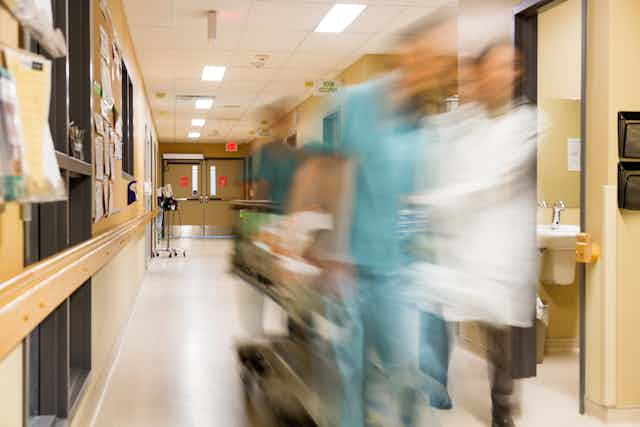Bob has arrived at the emergency department at 10am on a Tuesday after breaking several fingers slamming his hand in a car door. Bob is quite anxious; he speaks quickly and paces around. When asked to sit and explain what has happened, he provides an articulate account of events. A look at past medical records indicates Bob has recently been admitted to hospital for alcohol withdrawal. Bob’s blood alcohol concentration is 0.35% (or 0.35 grams per decilitre). For the average person, this could be fatal. But Bob is sitting upright with little outward cues he has been drinking heavily.
Now we turn to Bruce. Bruce stumbles up the street at 1am on a dark Saturday night. He loses his footing more than once and pauses multiple times as it seems he is struggling to avoid throwing up. Bruce’s speech is slurred and incoherent. Suddenly, he collapses in the street. When passers by check on him, they notice considerable cuts and bruises to his head. The man isn’t drunk; he was in a fight earlier that night and has a head injury.
These examples demonstrate “common sense” doesn’t always tell you who’s drunk and who’s sober. While slurred speech or lack of coordination might help, we cannot apply these cues in all circumstances.
These cues can be masked in people with high levels of tolerance to alcohol, or displayed by people who are not under the influence but have medical conditions with similar symptoms. For instance, both head injuries and diabetic ketoacidosis (when people have very high blood sugar levels in type 1 diabetes) have symptoms that mimic being drunk.
So what if Bruce, who seems drunk but is completely sober, turns up to emergency? Would staff have made the right diagnosis?
Mistakes could be deadly
Many of the issues surrounding correctly diagnosing someone with alcohol intoxication apply to correctly diagnosing someone who’s taken other drugs; mistakes could lead to illness and death.
The consequences of falsely identifying someone as intoxicated when they really have a life-threatening condition can be severe; they can receive the wrong treatment, or not receive treatment at all.
It is equally important to correctly identify intoxication with alcohol or other drugs, especially identifying the exact substance taken as some drugs can produce seemingly similar effects. Again, correctly identifying intoxication avoids giving medications incompatible with what the person’s taken.
While alcohol and drug testing (for instance blood or urine tests) is useful to determine intoxication objectively, their cost and time constraints may sometimes mean this is impractical. So, health care staff must accurately pick up on visual and verbal cues to tell if someone’s intoxicated or not.
But clinical suspicion alone may lead to missing a significant proportion of people who are intoxicated. In one study, trauma surgeons failed to identify 23% of patients who were acutely alcohol intoxicated.
Why intoxication might be missed
In one study that assessed emergency doctors’ and nurses’ knowledge of and attitudes to intoxication, most (73.8%) had not received specific training about drug and alcohol issues.
And as many people go to the emergency department with drug and alcohol related issues over the weekend or after hours staff may not have enough time to interact sufficiently with each patient to pick up intoxication cues.
In some cases it may not be whether someone is intoxicated, but what they are intoxicated with that’s the issue. For instance, someone may have taken a novel psychoactive substance (a designer drug) or more than one substance at once. These make it particularly difficult to spot and so provide the right treatment.
Bias may also play a role. In the trauma surgeon study, patients who the surgeons thought were dishevelled or of low socio-economic status were more likely to be falsely suspected of being drunk. And men were twice as likely as women to be falsely suspected of being drunk. But doctors were more likely to miss intoxication if patients were “well groomed”.
These issues are also relevant for first-responders as the ability for police, ambulance staff, and firefighters to correctly identify alcohol (and other drug) intoxication will influence how they approach and interact with people.
How about the rest of us?
So with these experienced and trained health workers potentially missing or misinterpreting the signs of intoxication, what chances do the rest of us have?
We might tell if friends and family are drunk because we know them sober so can compare their behaviours. If we try to tell if a stranger’s drunk, the context (such as a bar) might help, or it might be deceptive.
For drugs other than alcohol, we might know what our friends or family have taken. This information is vital for health professionals to know, so tell paramedics or other health workers so they can make the right treatment choices, even if this makes you feel uncomfortable. In the majority of drug overdoses police will not get involved.
What we need to do
It is astonishing how little research has been devoted to the topic of accurate detection of whether or not someone’s drunk or on drugs. We still can’t be certain people are receiving adequate training in this area, not only for individual substances but also if they have taken more than one substance.
How much someone’s taken and individual differences in how people respond to these substances also complicate the picture.
As there are a range of potential reasons why clinical suspicion may not be sufficient to detect intoxication (or rule out conditions that mimic intoxication), this suggests objective alcohol and drug testing may need to be more widely applied.
Knowing how to reliably assess intoxication will benefit the health services (correct diagnoses), first responders in general, and ultimately the community.

